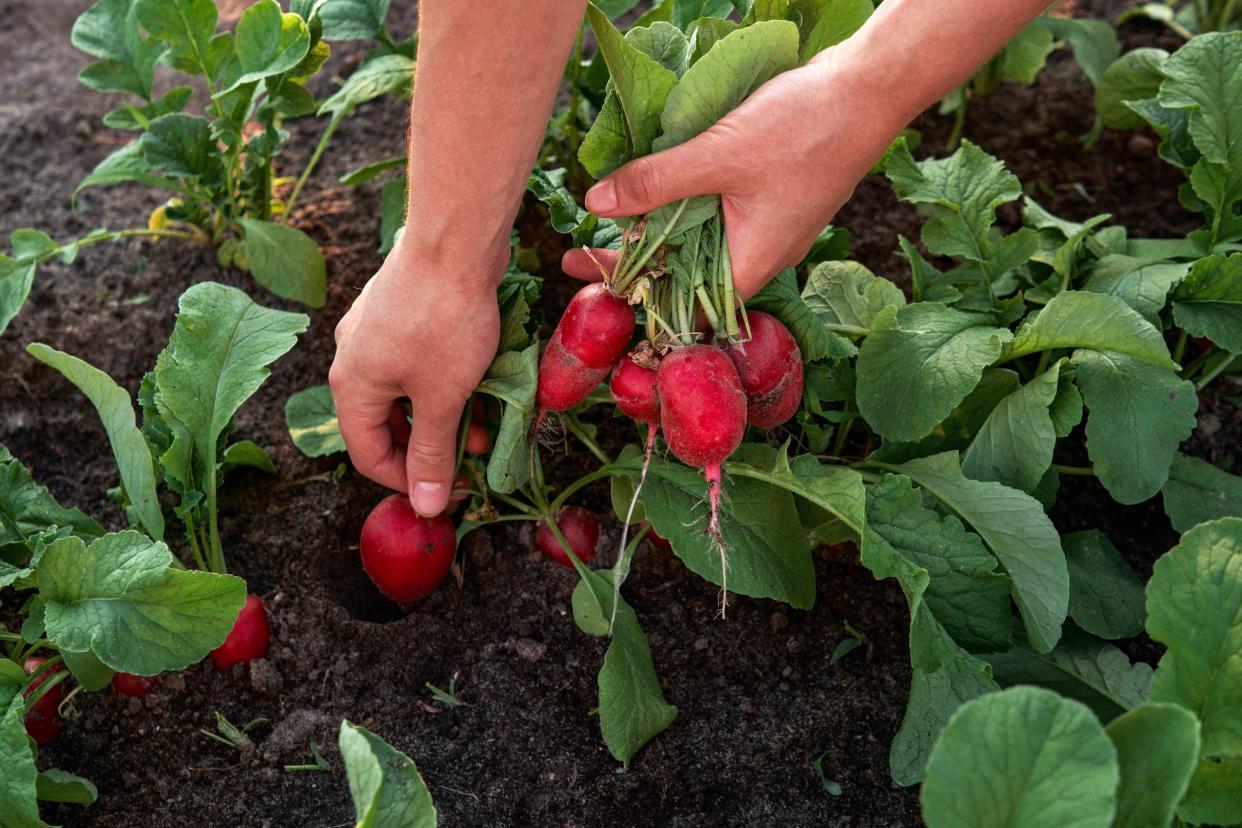How and When to Harvest Radishes for Peak Flavor

Ipinchuk / Getty Images
Radishes (Raphanus sativus) are notorious for their fast production, growing from seed to harvest in as little as 21 to 30 days. While red, round radishes are the most commonly conjured, radishes come in all sorts of shapes, sizes, and colors. Depending on the variety, they can be spherical or oblong like a carrot, and might be red, green, white, pink, purple, or yellow.
If you're a beginner gardener, this quick-growing root vegetable is a perfect place to start your growing journey. For a successful harvest, follow these tips for how to grow and harvest radishes.
How to Grow Radishes
Radishes grow best when directly sown in cooler conditions, and can be grown in spring and fall. You can plant radish seeds as soon as the soil can be worked. Allow about one inch between seeds in the row.
Many radish varieties mature very quickly; to ensure you have an ongoing supply of radishes and don't just harvest them all at once, sow seeds weekly (a gardening technique known as succession planting). Once spring temperatures reach 65 degrees, stop planting radish seeds, as heat will cause them to bolt, which means the plant is going to seed.
If your radishes don't form roots, that could be a sign that there is excessive nitrogen in the soil—do a soil test to confirm. A rapid onset of hot weather or overcrowded garden beds could also be the cause. Make sure your radishes have ample room to grow and mature fully.
Want more gardening tips? Sign up for our free gardening newsletter for our best-growing tips, troubleshooting hacks, and more!
Tip
Before you plant radish seeds in your garden, take note of when the variety should be ready for harvesting. Smaller varieties might be ready in as little as 21 to 30 days after sowing, whereas larger ones might take up to 60 days. Make a note or set a reminder on your calendar so you'll be aware of when to prepare to harvest radishes.
How to Know When a Radish Is Ready to Be Harvested
It can be challenging to know when it's the right time to harvest root vegetables like radishes. After all, they grow underground and aren't as easy to observe as cucumbers or tomatoes. However, there are a few signs to look for to be sure your radishes are ready to be harvested.
You're within the window of time in which that radish variety reaches maturity. (Different varieties have different growing times, so be sure to check the seed packet to confirm.)
The above-ground radish greens are four to six inches tall.
In general, the roots should be about around one inch in diameter, which you should be able to tell by the shoulders of the radish emerging above the soil.
How to Harvest Radishes
Once you're certain that your radishes have reached maturity, you'll want to harvest them. Don't wait too long; you want to pick them at the right time for peak flavor and texture. If they stay in the ground too long, they will get fibrous and develop a strong, unpleasant taste.
Using your finger or a small garden trowel, scrape away the soil above the radish root. If it is one inch in diameter, it's ready to be harvested.
Grab the radish at the base of its greens and pull straight up. You may need to gently wiggle it to loosen it from the soil, but it should emerge easily.
Separate the root from the greens. If left attached, the leaves will draw out moisture and nutrients from the radish bulb.
Wash each radish under cool, running water and rinse the radish greens, if keeping.
Store radishes in an airtight, resealable container in the refrigerator's vegetable crisper drawer for one to two weeks.
Frequently Asked Questions
What happens if you leave radishes in the ground too long?
If left in the ground too long, radishes get fibrous and develop a strong taste. For optimal flavor and texture, it's best to harvest them as soon as they reach full size. If you accidentally leave a radish in the ground past its optimal harvest time, you can still keep growing it to save seeds.
Why are my radishes long and thin?
As a root vegetable, radishes need loose soil to expand and develop thick roots that grow into bulbs. If your radishes are long and thin, it could be a sign that the soil is too compact.
How do you tell if your radishes have bolted?
If your radishes have started developing blooms, that means they have bolted. This happens when it starts to get too hot. Radishes that have bolted will have a more bitter flavor and be woodier in texture.
Read Next: 15 Radish Companion Plants You Should Know Before Planting
Read the original article on The Spruce.

